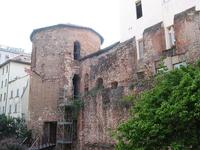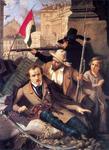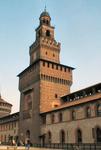Milan » City Info » History
- Early Settlements:

Milan’s history goes back to 600 B.C with the Gauls who are credited with the establishment of the city. In the centuries coming by, it became the capital of the Celtic tribe who were known by the name of Insubres. As time passed by, and the Romans were expanding their empire, they arrived in Milan. Then called as Mediolanum, it was already a very powerful city being the capital of the Cisalpine Gaul region. When Emperor Augustus assumed rule, he declared Mediolanum as the eleventh region in Italy. With increasing economic and strategic power ensured to it from time to time, it took time for Mediolanum to become the second largest city after Rome. In 3rd century A.D. the Roman Empire fell apart and was divided into two with Milan becoming the residential and administrative centre for Emperor Diocletian. Milan went under many rampages in the current years when Attila the Hun destroyed it in 452 A.D. and Goths in 539 A.D.
To retain its dominance, Milan went through long ensuing battles with other cities in Lombardy region resulting in interference of Frederick I Barbarossa. By 1127, the cities of Lodi and Como were wiped out by Milan. Due to intervention by Frederick, Milan came under complete and direct authority of the Holy Roman Empire. But it could not last long, until 1162 when the Milanese people had to seek refuge elsewhere after the fortifications of the city were razed. This war went till 1183 until the Peace of Constance was signed. But during the middle years, Milan played an important role in Battle of Legnano. After the war when city was rebuilt, its prestige and economic status was restored to an extent that nobody could even come to its level over the next century.
- Dynastic Clashes:

By the 1200’s with Milan’s growing power, its political system finally became feudal (“Seigneury”). This change in political background had a considerable impact on the landscaping of city with new buildings, fortifications and streets. But this feudalism ended when the influential Visconti family seized power over Milan and ruled it as ‘lords’ from 1277 – 1477. The democratic system ended and like many other Italian cities, Milan also underwent the rule of aristocracy. During the Visconti rule, the city prospered along with all other cities that the family brought under their rule. These included the cities of Bergamo and Novara, Cremona, Como and Lodi, Piacenza and Brescia. The construction of the Milan Cathedral (Dumno) started in 1386 during the Visconti rule, which today has become symbolic with Milan. After the death of Filippo Maria, the last duke of Visconti, Milan did experience Republican rule for some years until Francesco Sforza assumed power in 1450. Fransesco’s rule was a boon for Milan as he expanded and transformed the city into a significant metropolitan area with artistic constructions such as Castello Sforzesco, Church of Santa Maria delle Grazie and the Ca' Granda. The Sforza duchy also included Ludovico il Moro who was also instrumental in encouraging agricultural and silk industry development. During his era, painters and architects such as Donato Bramante and Leonardo da Vinci were called to court, which motivated art and culture in Milan.
- Spanish and Austrian Rule:

As the rule of the Sforza began to vane, Spanish and French monarchies started their conquest upon Milan and Northern Italy. But Lombardy enjoyed autonomy for 14 years after the defeat of King Francis I of France in the battle of Pavia in 1525. When Milan was under the rule of Francesco Sforza, it was with the support of King Charles I of Spain. When Sforza died in 1535, Milan and other areas of Italy directly came under the rule of Charles, initiating the era of Spanish rule which extended over 170 years. This rule changed much of Milan transforming it into a province that was burdened with taxes and weighed down by diseases such as plague and non-existent development. But in the 17th century, the arrival of the Borromeo family (Carlo and Federico), granted a spiritual and cultural transformation to Milan. But with the great European Wars of the 18th century brought in Austrian domination which completely changed the city. There was an economic, cultural, political and artistic turmoil; in a positive sense thanks to the Habsburg dynasty.
- Napoleon Rule:
Napoleon arrived in Milan in May 1796 when he was welcomed with great enthusiasm, as he was thought to be a supporter of democratic rule. But his rule didn’t last long and with his fall in 1814, the Lombardy region was reinstated to Austria. But the Austrians and the Italians didn’t approve much of each other. In reaction there was an uprising from the Milanese which failed resulting in Joseph Radetzky's authority over Milan.
- Italian Kingdom:

The Austrians were forced to leave quickly in 1859 and Milan was attached to the Kingdom of Piedmont which later became Kingdom of Italy. Milan became the economic and cultural capital of Italy, and Rome was the administrative capital. During this period grand constructions were undertaken such as Galleria Vittorio Emanuele II and Cimitero Monumentale.
- Fascism:

In 1919, the fascist party was founded in Italy due to the numerous strikes and the turbulent climate resulting from it. People did not revolt against dictatorship except for a few. Some great works of architecture such as Central Station and the Triennale were built during this era. The end of World War II resulted in the Italy’s makeover as an industrial area rather than as an agricultural country. Immigrants from the south of Italy arrived in the city in search of work which caused a financial boom and increase in economic wealth of Milan. Today fashion and industries such as printing, publishing, chemicals, industry, and machinery rule the trade.
Search news: Advanced
Contact our Advertising team for Advertising or Sponsorship on TravelAgents.com NetworkThis site is owned and managed by WN Network.
